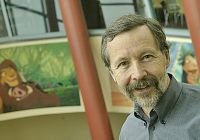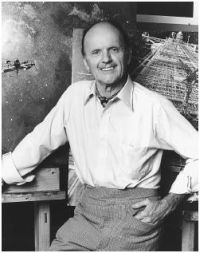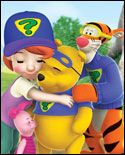 Disney animation gets Pixar-ization:
Disney animation gets Pixar-ization:
Catmull thinks a radical shift is needed
February 23, 2007
From Variety - by Ben Fritz
 Walking up the stairs of the Disney Animation Studios building, Ed Catmull talks about change.
Walking up the stairs of the Disney Animation Studios building, Ed Catmull talks about change.
"We took down as many walls as we could," he says, showing off a bright and open second floor -- a stark contrast to the narrow hallways and separate rooms on other floors.
Entering his modest office in a structure that only opened in 1994, he adds: "We are planning to build an entirely new building."
There's no hiding that the new president of Walt Disney Feature Animation thinks a radical shift is needed both physically and psychologically at the venerable toon unit, which has been struggling since the late '90s.
That attitude is exactly why Bob Iger brought on Catmull, a computer science Ph.D. who started Pixar as a division of LucasFilm in 1979 and led the company from the time Steve Jobs bought it in 1986 until its acquisition a year ago, when he took his new job.
Together with chief creative officer John Lasseter, his much better known partner, Catmull is charged with reviving the biggest name in animation while simultaneously keeping up the creatively and commercially unblemished track record of
Pixar, which the two continue to head under the combined rubric of WDFA.
It's a monumental task, but Disney CEO Iger bet $7.4 billion that Catmull and Lasseter can handle it when he decided to acquire Pixar last year.
"More than anything else, the impetus for the Pixar deal was getting two experienced leaders who can give a shot of adrenaline to Disney Animation," says studio topper Dick Cook. "You can't come close to calculating what that means in the long term for the company in terms of new characters, stories, and lands for films and parks and publishing and more."
Former Pixar CEO and current Disney board member Steve Jobs is also modestly involved, as he sits on a six-person animation oversight committee for the Mouse that also includes Catmull, Lasseter, Iger, Cook and chief financial officer Tom Staggs.
The hope is that the Pixar team will create and maintain properties to flow throughout Disney's many ventures, such as a "Finding Nemo" ride set to open this summer at Disneyland and a new "Cars" section on Disney.com.
But their top priority is reviving Disney Animation Studios. From new offices to new talent, a new development process, and an openness to the formerly shunned technique of hand-drawn toons, WDFA is in the midst of its biggest changes since the late '80s, when Jeffrey Katzenberg re-energized the then-ailing unit that was turning out only one film every four years.
The problem these days isn't quantity, but quality. In the past six years, WDFA released seven toons, only two of which made more than $100 million domestically and only one of which, 2002's "Lilo and Stitch," was also positively received by most critics and the animation community.
Disney artists felt that lack of success acutely, which is why morale was particularly low in 2005. But insiders say that feeling changed almost overnight when Catmull and Lasseter, two of the most respected figures in the industry, took over.
Disney animators use words like "euphoria" to describe what they felt at the time. Today, those feelings are more tempered, thanks to an unexpected round of cutbacks in December that saw Disney Animation lay off 160 employees, or about 20% of its staff.
"Everybody recognizes the fact that they're trying to change the culture down here for the better, but it's safe to say that the pixie dust that surrounded their arrival has pretty much disappeared," says one source close to Disney Animation.
Catmull says the layoffs weren't a result of corporate pressure, but his and Lasseter's decision to move Disney Animation from putting out one pic per year to one every 18 months.
"It took Pixar 10 years to get to one movie per year," Catmull notes. "We had to get things back in balance and then grow from there."
Such sentiments, while reasonable, underline why many in the animation community say Mouse House artists are struggling with an inferiority complex: Pixar kept its leadership, didn't experience any layoffs, and is putting out one pic per year.
In other words, the 72-year-old Disney Animation has to follow the example of its 20-year-old sibling.
That doesn't mean that the younger studio feels totally comfortable with its new relationship either. In the two years leading up to the acquisition, Catmull, Lasseter and then-CEO Steve Jobs were psyching their company up for a future without the studio that had distributed all their movies. Due largely to a dismal relationship with Michael Eisner, the three Pixar principals frequently bashed the Mouse at company-wide meetings.
"A lot of people felt betrayed when they all suddenly took jobs there," notes one source close to Pixar.
The two execs face a balancing act as they try to alleviate concerns and foster creativity in two places at once. To do that, they split time equally between Burbank and Emeryville and endeavor to keep the two studios unique and separate. They're keeping distinct names and while directors from DAS and Pixar sometimes give each other notes, animation work isn't shuffled back and forth between the two.
They're also giving each studio ownership of the characters they create. Lasseter recently said that the "greatest part of the merger" was that Disney abandoned its plans to make "Toy Story 3" and that Pixar is now making the film in-house.
Similarly, though they don't directly control the unit, Catmull and Lasseter clearly influenced the Mouse to stop direct-to-DVD unit DisneyToon from making sequels to animated theatrical features. It's now focused on spinoffs like "Tinkerbell" and a "Disney Fairies" pic.
But there's no denying that many of the changes being instituted at Disney Animation look very Pixar-esque.
Execs note repeatedly that they're trying to make the Mouse "a director-driven studio," a mantra that has served Pixar well with a braintrust of talented helmers that includes Lasseter, Brad Bird ("The Incredibles"), Pete Docter ("Monsters, Inc.") and Andrew Stanton ("Finding Nemo"). Catmull repeatedly states that the days of studio exec interference are over.
"It used to be that there were three levels of executives giving notes," he says of Disney Animation under its former prexy David Stainton. "Now John and the directors give notes to each other, but they're all suggestions and nothing is mandatory. We judge progress based on how well the team is working together."
First Disney toon to get at least some of that treatment is "Meet the Robinsons," which comes out next month. Though it was partway through production when Catmull and Lasseter came on, one of their first tasks was a six-hour notes session involving them, Stanton, and the film's director, Steve Anderson, last March that resulted in the pic being delayed by three months to allow for changes.
"At the time it felt like one of the hardest days of my entire life," says Anderson. "But what's amazing is that at the end, they put the control back in my hands and said it was up to me to figure out what I wanted to implement and how. John and Ed immediately stressed that the people responsible for the movie, whether it succeeds or fails, are the filmmakers."
Though the pic was too far along for radical restructuring, Anderson ended up making major changes to the villain, the Bowler Hat Guy, after the Pixar brain trust told the director that they didn't find the character menacing.
The next pic on Disney's slate, "American Dog," which will likely bow in late 2008, shows that even at a director-driven studio, filmmakers aren't sacrosanct. Helmer Chris Sanders, who also directed "Lilo and Stitch," recently left the studio over what insiders say were irresolvable creative differences with Lasseter on the pic's direction. Vet story artist Chris Williams is now directing.
Similarly, this summer's Pixar release "Ratatouille" is the first film from that studio to see a director ankle after years of development. Jan Pinkava, who was set to make his feature debut after winning an Oscar for Pixar short "Geri's Game," was replaced in 2005 by Bird.
Despite some tumult, Catmull and Lasseter are clearly believers in developing a brain trust of directors they charge with developing and overseeing projects at both studios. At Disney, they're not only relying on existing talent, but bringing on respected directors who left amid the studio's problems in the past year.
First to come back were Ron Clements and John Musker, the team who directed "The Little Mermaid," "Aladdin," "Hercules" and "Treasure Planet." They're developing "The Frog Princess," which has a very good shot at becoming the first hand-drawn project released by Disney under its new regime.
Catmull says there are several other Disney vets he hopes to bring back soon.
Whatever combination of vets and new talent end up heading Disney's slate going forward, Catmull says his No. 1 goal, the one that will make him feel he made a difference in his new job, will be seeing them come together.
"Ultimately you are judged by your films," he grants, "but the only way I know to make sure you make good films is to create a healthy and vibrant community of filmmakers."
Disney Matte Artist Peter Ellenshaw Dies at 93
February 17, 2007
From a Disney Press Release

Peter Ellenshaw, the Oscar®- winning visual effects pioneer and matte artist who worked his magic on such classic Disney live-action films as "Mary Poppins," "20,000 Leagues Under the Sea," "Darby O'Gill and the Little People," "Treasure Island," and "The Black Hole," passed away at his home in Santa Barbara on Monday (2/12) at the age of 93.
As a hand-picked member of Walt Disney's creative team, Ellenshaw was called upon to create a wide variety of visual effects for the Studio's films, and even painted the iconic first map of Disneyland that was featured on all the early postcards and souvenir booklets. Ellenshaw began his association with Walt Disney in 1947, when he was tapped to work on the Studio's first live-action film, "Treasure Island" (1950), and continued working there until his retirement in 1979 following "The Black Hole."
Federal court dismissed Winnie the Pooh copyright lawsuit
February 16, 2007
From the Associated Press - by Staff writer

A federal court judge has denied an attempt to strip the rights to merchandise the Winnie the Pooh characters from the family that has long held them.
The ruling comes as a blow to The Walt Disney Co., which had hoped the heirs of the original writer and illustrator of the Pooh books would be able to reclaim their copyrights and assign them permanently to Disney.
U.S. District Court Judge Florence-Marie Cooper on Friday granted a motion for summary judgment to Stephen Slesinger Inc., which has held the merchandising rights to Pooh since 1930 and has licensed them to Disney.
Disney and Slesinger have been locked in a 16-year battle in California state court over those rights, with Slesinger claiming Disney owes millions of dollars in licensing fees on profits made from DVDs, video games and other electronic items featuring Pooh, Tigger and friends.
That dispute is still pending, although a state court threw out Slesinger's claims several years ago after finding representatives of the company illegally obtained evidence after rifling through Disney's trash. That ruling is being appealed.
In 2002, Claire Milne, the granddaughter of Pooh creator A.A. Milne, and Harriet Jessie Minette Hunt, the granddaughter of illustrator E.H. Shepard filed a complicated copyright claim in federal court, seeking to regain the rights to the characters from Slesinger.
Milne's claim had previously been rejected by a federal court and last June, the U.S. Supreme Court let that decision stand. Friday's ruling throws out a similar effort by Hunt. The battle is far from over. Earlier this month, Slesinger petitioned the U.S. Patent Office to cancel Disney's trademark registrations over the 80-year-old bear and his friends.
Disney moved immediately to block Slesinger's petition, saying the petition duplicated Slesinger's requests in an ongoing lawsuit between the two companies.
Disney says plans intact for 2D and 3D animation
February 14, 2007
From a Disney Press Release
Refuting months of speculation that Walt Disney Feature Animation would be retooled and rebranded exclusively to traditional animation, Ed Catmull, president of Pixar and Disney Feature Animation revealed plans for merely a partial return to 2D.
Meanwhile, it was formally announced that TOY STORY 3 is being made at Pixar with Lee Unkrich, co-director of Toy Story 2 at the helm. Plans are to release in 2009. Tom Hanks and Tim Allen are signed as the voices of Woody and Buzz Lightyear.
Catmull reiterated that Pixar's director-centric vision has been adopted at Disney and that quality and storytelling are the keys to a successful business plan, not animation style. Catmull also said Disney will offer a mix of 3D and 2D. A new and more flexible pipeline is being implemented to accommodate both. Plans are in the works to build a new Feature Animation studio in Glendale. The first 2D feature in development is The Frog Princess by Ron Clements and John Musker, co-directors of the Little Mermaid and Aladdin.
John Lasseter additionally confirmed that Disney story artist Chris Williams has replaced Chris Sanders as the director of American Dog, for release in 2008. Williams caught the attention of Lasseter with his work on Disney's next 3D short that he's developing, Golgo's Guest, about a strange meeting between a Russian frontier guard and an extraterrestrial.
Nicolas Cage on board to wear Disney's Sorcerer hat
February 13, 2007
From the Walt Disney Company
Nicolas Cage will star in a live-action feature film version of the classic tale of "The Sorcerer's Apprentice" for Walt Disney Pictures. Lawrence Konner and Mark Rosenthal are writing the screenplay, which takes its inspiration from Johann Wolfgang Goethe's 18th century poem, which in turn was the inspiration for the classic Mickey Mouse animated sequence from Disney's 1940 "Fantasia."
"Sorcerer" is being envisioned as a fantasy adventure set in contemporary New York, where a powerful sorcerer is in need of an apprentice. Cage would play the sorcerer. While not based on a ride like the "Pirates of the Caribbean" films, the in-development project continues Disney's trend of reimagining classic Disney titles as live-action, event pictures.
A director has not yet been attached to the project.
Disney Fairies coming to DVD in 2008
February 12, 2007
From the L.A Times and Gary Chambers - by Staff writers
Tinker Bell finally has something to say.
The famed fairy from "Peter Pan" will speak for the first time in "Tinker Bell," a computer-generated animated movie that Disney said Friday it planned to release on the home video market in the fall of 2008. Brittany Murphy will provide the voice.
Disney Fairies builds upon the enormous popularity of Tinker Bell and introduces children to her secret, magical world of profiteering and merchandise saturation, and a new circle of enchanting fairy friends.
|